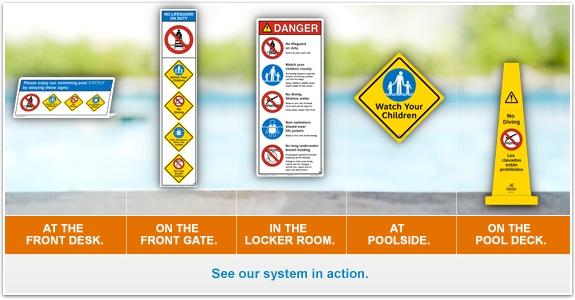Water Safety Signs That Are More Apt to Get Kids' Attention
Posted by Geoffrey Peckham | 16th May 2016

Who can predict what kids will or won’t pay attention to? Along with my wife, I helped to raise four children, now all in their 20s, and each one of them approaches life differently. Predicting what they will pay attention to and how they will act was (and still is!) impossible. But that knowledge doesn’t stop Clarion from creating safety signage for places, like pools and beaches, where children will be present.
A couple of years ago, working alongside Dr. Tom Griffiths of the Aquatic Safety Research Group, we designed a set of pool safety signs that prominently display colorful ISO-formatted safety symbols. The goal of the symbols was, first and foremost, to catch the attention of people, adults and children alike. It’s sort of obvious to state, but a safety sign is useless if it goes unnoticed. And THAT is the situation with the vast majority of aquatic safety signage in use today. Typically these signs are nothing more than “list of rules” that use only words, no symbols. People – adults and children – walk right by them, not giving them the time of day. My guess is that everyone that enters these environments has other things on their mind and it, quite literally, takes too much time to read these signs, so no heed is paid to them.
Dr. Griffiths and Clarion decided we’d try to change that. We put symbols on the signs and did so in a way that made them more prominent than any text appearing on the sign. Your eye, now, can take in the symbol or symbols at a glance. It takes much less effort to “read” and understand these signs when compared to the “list of rules” signs. Words still appear on our signs, but they mainly serve to reinforce the message of the symbol(s). If people don’t understand what the symbol means, then the words serve as a way to teach them. Then, once learned, the symbols’ messages can be recalled with each subsequent viewing.
We then took this same design idea and applied it to beach safety signage – developing a whole set of new safety signs, first, for the Hawaiian Lifeguard Association. We expanded that set of signs to take in other hazards related to river, pond and lake environments. And then we went even further still when we applied these principles to the safety signs systems we designed for large waterparks, like the Atlantis resorts in the Bahamas and in Dubai, where pools, ponds, rivers and beaches exist. And children abound!
In all of these Clarion aquatic safety sign systems, symbols play an integral role to visually communicate risk to all ages. The goal, as with all of the safety signs and labels we design and produce for 180+ industries, is to make the world a safer place. And it’s being done!
To learn more, watch our short video on “ Preventing Swimming Pool Accidents and Lawsuits.”
Geoffrey Peckham
CEO, Clarion Safety Systems

This blog is part of a series of regular posts from our CEO, Geoffrey Peckham, to share his insight. Geoffrey serves as chair of the ANSI Z535 Committee for Safety Signs and Colors and chair of the U.S. TAG to ISO/TC 145 – Graphical Symbols. He has also been selected as a member of the U.S. TAG to ISO/PC 283, an ISO committee writing a new standard, ISO 45001 Occupational Health and Safety Management Systems, which will, when finished, define global best practices for workplace safety. In addition, he is an active member of many industry-specific standards committees related to safety signs and labels for buildings, ships, machinery and products.
